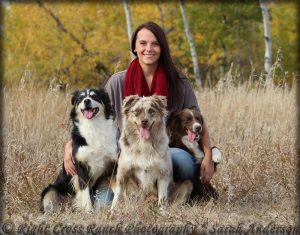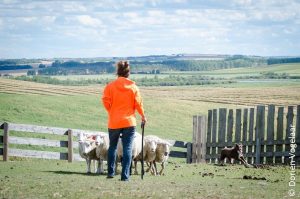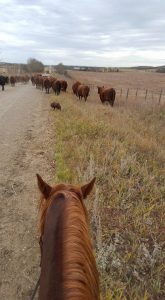 Sarah Martin, of G-S Ranch, runs purebred red Angus with her husband and his family in northern Alberta, Canada. She is available for clinics.
Sarah Martin, of G-S Ranch, runs purebred red Angus with her husband and his family in northern Alberta, Canada. She is available for clinics.
WAS: How did you get your first dogs? What did you look for? How did you know what to look for? Did you get what you wanted?
SM: As stated above I got into my first working dog with a friend. I wanted a dog and his only stipulation was that I needed to find a working Australian Shepherd. I researched as best I could with the little knowledge that I had. I found a local breeder that had a litter with working lines – as far as I could tell. I didn’t really know what to look for. As far as I can remember I asked about hips and color. I really had no idea what to ask for. I had assumed because they where working bred; they would work. I definitely lucked out and got more than what I wanted. Mya has played an extremely important role in the teaching department. She was not an easy dog to train for a beginner and I think she would be even better if I had her as a pup today.
Billy was my second pup that I purchased from Pam Arlitt – I am not sure about my initial email to her but I do know that I was very clear when I told her that I wanted a cow dog. Pam was amazing to deal with – the part that I really liked is that she waited until Billy was 10 weeks or so to determine if she would be suitable for me. To me that speaks volumes. After Mya I knew what I liked, didn’t like and what I wanted in my next dog. Billy has been far more than I could have imagined.

Sarah and Billy on the G-S Ranch
WAS: How did you go about training those first dogs?
SM: I was lucky enough to have a mentor that helped put a handle on her – just her basic walk-up, lie down, and that’ll do. Mya is very natural and reads her stock well with a great sense of group. Outside of her commands she was basically just sent out and put on the job alongside an experienced dog. I was very blessed to meet a gal by the name of Deanna Lonsberry through the stock dog club as she not only helped me with Mya but encouraged me to take my first stock dog clinic with Elvin Kopp. Shortly after that I met a wonderful lady by the name of Joan Holmes; she has been my Aussie mentor. Deanna, Elvin, and Joan have all been instrumental in developing my love and passion for working dogs. Billy was my second female. She was trained drastically different than Mya and you can certainly tell. The method I used then is still the method I use today – because it works.
WAS: What advice would you have for someone just trying a dog on a working operation for the first time? What to
look for in a dog, in a breeder, how to get a good start on a dog, especially if you don’t have the time and energy to go to a trainer?

Moving cattle to new pasture.
SM: Do your research and ask a lot of questions; find someone that is willing to mentor you. If at all possible find a well started or broke dog. You may pay more but they will be worth their weight in gold when it comes to teaching you and dog breaking your stock. You will be able to make more mistakes with a broke dog then a pup. Before purchasing a dog I would audit a few different clinics – you will get a good idea of what you like, what you don’t like, what you are getting into, and who you would potentially want to purchase a puppy from. Clinics are a great way to start; you will be able to see a number of different dogs at different stages of training. Make a list of what you want in a dog, for example:
- natural confidence on heads
- sense of group
- thoughtful
- biddable
- rate
- clean low heel
- natural outrunner
- degree of eye: strong or loose
- high pressure situations like pen or alley work
- high drive or easy going
WAS: What should you look for in a breeder?
- Open to any and all questions. Ask them what their policies/contracts are? What happens if the dog does not work out – unfortunately the best litters on paper don’t always work out in the end. It is important to understand that not every puppy out of every litter will be a keeper and that single puppy is not a reflection on the breeders program as a whole.
- Watch how they run their dogs and see how they handle their stock. If you like the way they handle their dogs and stock, chances are you will like the way they train.
- How do they use their dogs? Is it similar to how you run your operation at home. Do you want to use your dog for strictly pen work or gathers as well?
- Best case scenario is to find a breeder/mentor near you and look for a breeder that offers mentorship/guidance when needed.
- Have a goal with the puppies they are producing.
- Working quality and structure should be priority over aesthetics.
- Reputable – ask if you would be able to contact people who have purchased their puppies previously. Chat with them about their experience. Find out if the dog worked out for them and if not how was the situation handled?
- See what type of genetic/health testing they do?
WAS: What should someone look for in a dog?
- Watch the parents work; find out what their strengths and weaknesses are. If you want a strong heading dog – both parents should be strong on the head.
- Knowing what one wants in a dog is going to be different for everyone. The type of operation, housing situation, and goals are all going to determine what type of dog will suit you best.
- Pups: if the parents check off all your "must haves" purchase the pup. You will increase your chances of getting what you want if both the parents have what you are looking for. There are some traits that are “deal breakers” and others that are “livable.” What those traits are will be different for everyone.
- Mature dogs: watch the dog work in person if possible; if not get some video. Ask questions that will pertain to your operation; for example:
- why are they selling the dog
- what are the dogs strengths and weaknesses
- is the dog confident doing pen or alley work
- does the dog need a helper dog or strong enough to work on his own
- how far can the dog outrun
- what size of gathers can the dog complete
- can the dog work independently
- how biddable is the dog
- what is the dog natural at: heading, heeling, sense of group, rate, etc…..
A dog with natural ability is going to be much easier to train and handle then a dog that will need help as you will tell him what and when to do it. *** I do caution people about “started” dogs as everyone’s opinion is different when it comes to what started means. Not very many people want to sell their good dogs – so many of them will come with some sort of
baggage. Your job is to determine what that baggage is and if it is something you can live with. ***
WAS: Once you get a dog, how should we get a good start on it?
- As stated previously go to a clinic before you purchase your puppy. You will be able to see what you need to do to help prepare your pup for stock work. There is a set of dvds that I highly recommend, they were developed in the 80’s so some things have changed but the fundamentals are still the same. You can find them on Elvin Kopp’s website: thatlldoranch.com.
- Developing a working relationship with your dog outside of stock. They need to have structure and develop a bond with you before you will be able to train them on stock.
- I highly recommend purchasing 3-6 head of sheep. Sheep will allow you to put a foundation on your dog and keep you safer while you learn to read your dog/stock. You will not need to stay on sheep long; as soon as you have your foundation on sheep you can transition on to cattle.
- In learning from Elvin there are some key skills that need to be taught on sheep before going to cattle:
- stop
- recall
- back
- direction change
- working the flight zone


